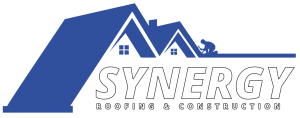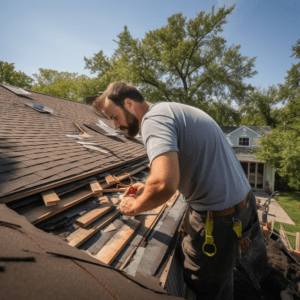Roof repair is an essential aspect of maintaining a safe and functional home. However, the cost associated with such repairs can often be substantial, leaving homeowners in need of viable financing options. This article aims to inform readers about various avenues for roof repair financing, including credit cards, personal loans, home equity loans and HELOCs, as well as government programs and grants specifically designed for this purpose. Additionally, it provides practical tips to assist homeowners in selecting the most suitable financing option based on their individual circumstances.
Key Takeaways
- There are several types of roof repair financing options available, including home equity loans, personal loans, credit cards, in-house financing plans, and government programs.
- Using credit cards for roof repair can offer convenience and flexibility, but it comes with high interest rates compared to other financing options.
- It is important to assess interest rates and compare lenders and loan products to ensure affordability and choose an option with lower interest rates, such as home equity loans or personal loans.
- Instant payment options, such as using savings or liquid assets, can be a viable choice for those who can afford to pay for repairs upfront and want to avoid lengthy approval processes, but it is crucial to consider one’s financial situation and explore other financing options if savings are insufficient.
Types of Roof Repair Financing
Different types of financing options are available for roof repairs, allowing homeowners to choose the most suitable method based on their financial situation and preferences. One common type of financing option is a home equity loan. This involves borrowing against the equity in one’s home to fund the roof repair project. Homeowners can typically qualify for larger loan amounts with lower interest rates compared to other types of loans. Another option is a personal loan, which can be used for various purposes including roof repairs. Personal loans are unsecured and do not require collateral, but they generally come with higher interest rates compared to home equity loans.
In addition to traditional loans, some homeowners may opt for credit cards as a financing option for roof repairs. Credit cards offer convenience and flexibility, but they often come with high-interest rates if not paid off within a specified period. Alternatively, some roofing companies offer in-house financing plans or partnerships with third-party lenders. These plans may provide more flexible payment terms or lower interest rates than traditional loans.
Lastly, government programs may also provide financial assistance for roof repairs. For example, the Federal Housing Administration (FHA) offers Title I Property Improvement Loans that can be used for various home improvements, including roofing projects.
Overall, understanding the different types of financing options available allows homeowners to make an informed decision based on their specific needs and financial circumstances when it comes to funding their roof repairs.
Pros and Cons of Using Credit Cards for Roof Repair
This discussion will explore the pros and cons of using credit cards for roof repair. One key consideration is the high interest rates associated with credit cards, which can significantly increase the cost of borrowing if not paid off quickly. Additionally, credit cards offer the convenience of instant payment options, allowing homeowners to quickly address their roofing needs. However, it is important to understand that utilizing credit cards can also impact one’s credit score, as missed or late payments can negatively affect this important financial metric.
High Interest Rates
High interest rates can have a significant impact on the affordability of roof repair financing options. When considering financing options for roof repair, it is important to carefully assess the interest rates associated with each option. High interest rates can result in increased monthly payments and overall higher costs over time. This can make it more difficult for homeowners to afford necessary repairs and potentially lead to financial strain. It is advisable to compare different lenders and loan products to find the most competitive interest rates available. Additionally, homeowners should consider alternative sources of funding such as home equity loans or personal loans, which may offer lower interest rates compared to credit cards or unsecured loans. By choosing a financing option with low interest rates, homeowners can ensure that their roof repair remains affordable while minimizing long-term financial burden.
Instant Payment Option
One potential alternative for homeowners seeking to make immediate payments is the instant payment option. This option allows homeowners to pay for their roof repairs upfront, without having to rely on financing or loans. With the instant payment option, homeowners can use their savings or liquid assets to cover the cost of the repairs immediately. This can be beneficial for those who prefer not to incur additional debt or interest charges. By choosing this option, homeowners can avoid lengthy approval processes and start the repair work promptly. However, it is important to consider one’s financial situation before opting for the instant payment option as it may deplete savings or disrupt other financial goals. Additionally, if a homeowner does not have sufficient funds available in their savings, they will need to explore other financing options such as personal loans or credit cards.
Credit Score Impact
The impact on an individual’s credit score must be considered when choosing a payment method for home repairs. Different financing options can have varying effects on one’s credit history and overall creditworthiness. For instance, taking out a loan or using a credit card to finance roof repairs may result in an inquiry on the individual’s credit report and could potentially lower their credit score temporarily. On the other hand, utilizing savings or paying with cash would not directly impact the credit score. It is important to note that consistently making timely payments towards any financing option can help improve one’s credit score over time. Additionally, individuals should carefully consider their financial situation and ability to repay before opting for any particular payment method, as failure to meet repayment obligations can lead to further negative impact on their credit standing.
Personal Loans for Roof Repair: What You Need to Know
Among the considerations for individuals seeking financial assistance for roof repairs, it is important to be knowledgeable about personal loans and their implications. Personal loans are a type of unsecured loan that can be used for various purposes, including home improvement projects such as roof repairs. These loans are typically provided by banks, credit unions, or online lenders.
When considering a personal loan for roof repair, it is essential to assess the interest rates offered by different lenders. Interest rates can vary depending on factors such as credit history and income level. It is advisable to compare multiple loan offers to secure the most favorable terms.
Personal loans also come with repayment terms that need to be carefully evaluated. Loan durations can range from a few months to several years, and borrowers should consider their ability to make monthly payments before committing to a specific term.
Additionally, borrowers should take into account any potential fees associated with personal loans. Some lenders may charge origination fees or prepayment penalties, which could affect the overall cost of borrowing.
Home Equity Loans and HELOCs for Roof Repair
This discussion will focus on the loan interest rates and approval process timeline for home equity loans and HELOCs used for roof repair. When considering these financing options, it is essential to understand the interest rates associated with them as they can have a significant impact on the overall cost of borrowing. Additionally, understanding the approval process timeline will help borrowers plan their roof repair project effectively and ensure timely funding.
Loan Interest Rates
Loan interest rates for roof repair financing are influenced by various factors such as creditworthiness, market conditions, and the loan terms. Creditworthiness plays a significant role in determining the interest rate for roof repair loans. Lenders assess an individual’s credit score, income stability, and debt-to-income ratio to gauge their ability to repay the loan. A higher credit score indicates lower risk for lenders, resulting in lower interest rates. Market conditions also affect loan interest rates. When economic conditions are favorable with low inflation and steady interest rates, lenders may offer more competitive rates. Conversely, during times of economic uncertainty or high inflation, lenders may increase interest rates to mitigate risks. Lastly, loan terms such as repayment period and type of loan can influence the interest rate. Generally, shorter repayment periods and secured loans tend to have lower interest rates due to reduced risk for lenders.
Approval Process Timeline?
The approval process timeline for roof repair financing options can vary depending on the lender and the specific loan program. Generally, it involves several steps that borrowers need to complete before their loan application is approved. Firstly, applicants are required to submit the necessary documentation, which typically includes proof of income, credit history, and other financial information. Once all the required documents are submitted, lenders will evaluate the borrower’s eligibility based on factors such as credit score, debt-to-income ratio, and employment stability. This process usually takes a few days to a couple of weeks. If the application is approved, borrowers will be notified and provided with loan terms and conditions. The final step is signing the loan agreement and receiving funds for roof repairs. It is essential for borrowers to carefully review all terms before proceeding with any financing option.
Government Programs and Grants for Roof Repair
Government programs and grants provide financial assistance for roof repair, ensuring that individuals have access to affordable options for maintaining their homes. These programs are designed to support low-income households, veterans, seniors, and individuals with disabilities who may struggle to afford necessary repairs or replacements.
One such program is the Weatherization Assistance Program (WAP), which offers grants to improve energy efficiency and weatherization measures in eligible homes. While this program primarily focuses on insulation and energy-saving measures, it also includes funding for roof repairs or replacements if necessary.
Another government initiative is the Single Family Housing Repair Loans & Grants program offered by the United States Department of Agriculture (USDA). This program provides loans and grants to low-income homeowners in rural areas who need assistance with repairing or replacing their roofs. The funds can be used for various home improvements, including roof repair.
Additionally, some local governments offer grant programs specifically aimed at assisting residents with necessary roof repairs. These programs often have specific eligibility criteria based on income level or property ownership status.
Financing Options for Low-Income Homeowners
One potential avenue for low-income homeowners is to explore financial assistance programs specifically designed to address housing needs. These programs can provide a range of options for financing roof repairs and renovations, allowing homeowners to address necessary repairs without incurring excessive financial burden.
One option available to low-income homeowners is the federally-funded Home Repair Program. This program provides grants or low-interest loans to eligible individuals or families who need assistance with home repairs, including roof repairs. The eligibility criteria for this program typically include income limits and residency requirements.
Another option is to explore loan programs offered by non-profit organizations or community development agencies. These organizations may offer loans with lower interest rates or flexible repayment terms specifically tailored for low-income homeowners. Some of these loans may be secured against the property, which could allow homeowners to access larger loan amounts.
In addition, local governments may also have their own financing programs in place to assist low-income homeowners with roof repair costs. These programs may offer grants, loans, or tax incentives to help offset the expenses associated with repairing or replacing a damaged roof.
It is important for low-income homeowners to thoroughly research and understand the terms and conditions of any financial assistance program they are considering. This includes reviewing eligibility requirements, interest rates, repayment plans, and any other relevant details. By exploring these avenues and taking advantage of available resources, low-income homeowners can find practical solutions that enable them to address their roofing needs without undue financial strain.
Tips for Choosing the Right Roof Repair Financing Option
When considering the selection of a suitable financial assistance program for addressing housing needs, it is essential to carefully evaluate and compare various factors such as eligibility criteria, interest rates, repayment plans, and other relevant details. In the case of roof repair financing options, homeowners should consider several tips to choose the right option.
Firstly, it is important to assess eligibility criteria for each financing program. Some programs may have income restrictions or require specific documentation. Homeowners should ensure that they meet all the requirements before applying.
Secondly, interest rates play a crucial role in determining the affordability of the financing option. Comparing interest rates offered by different programs can help homeowners select one with lower costs.
Thirdly, homeowners should examine the repayment plans offered by each financing option. Some programs may offer flexible repayment terms or allow deferment options during financial hardships.
Additionally, it is advisable to review any fees associated with the financing option, such as application fees or closing costs. These additional expenses can significantly impact overall affordability.
Lastly, obtaining quotes from multiple lenders can provide homeowners with a better understanding of available options and enable them to negotiate better terms.




